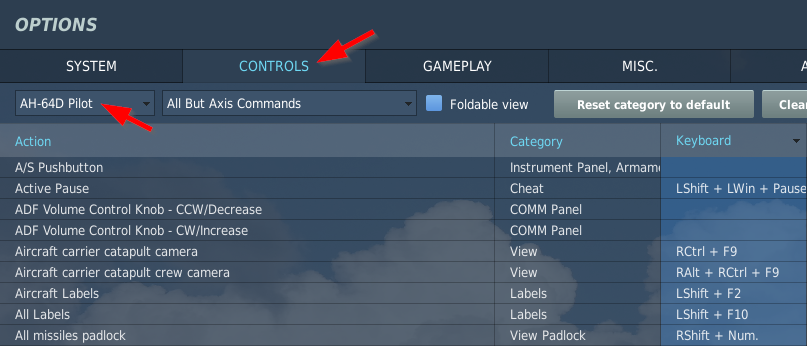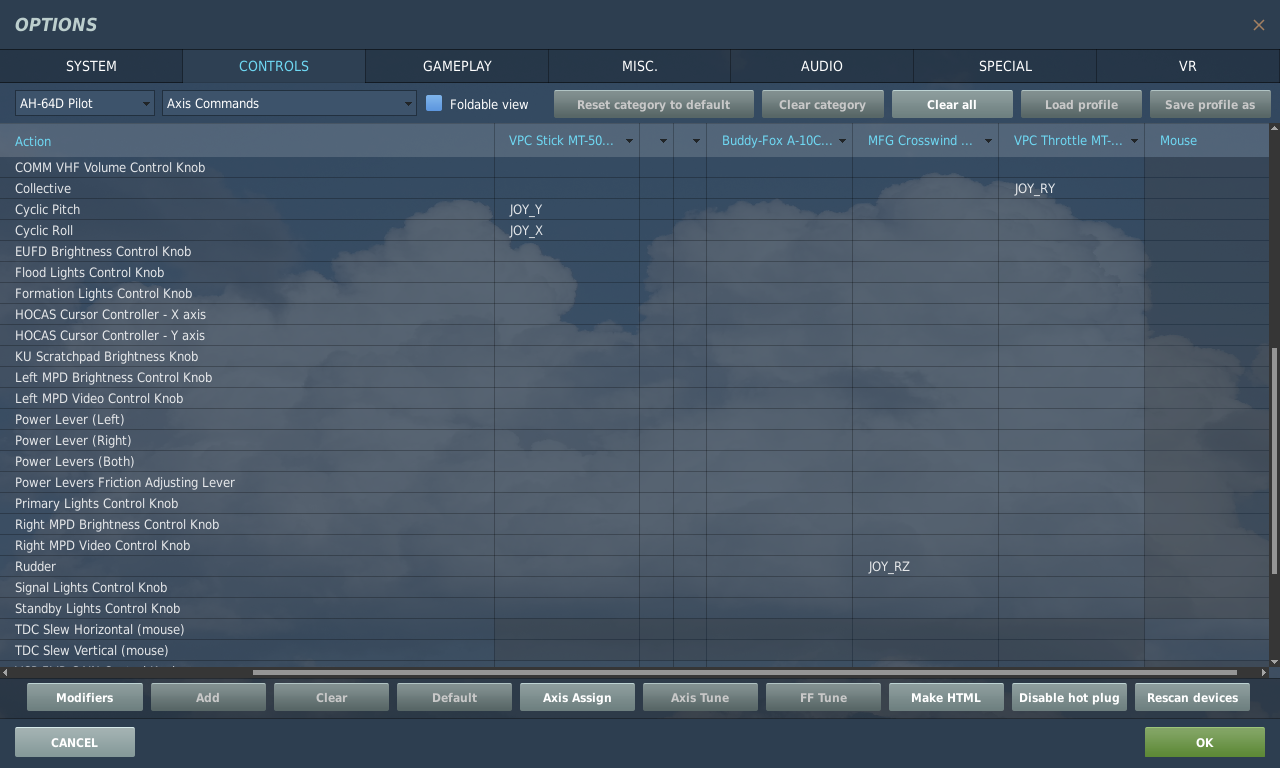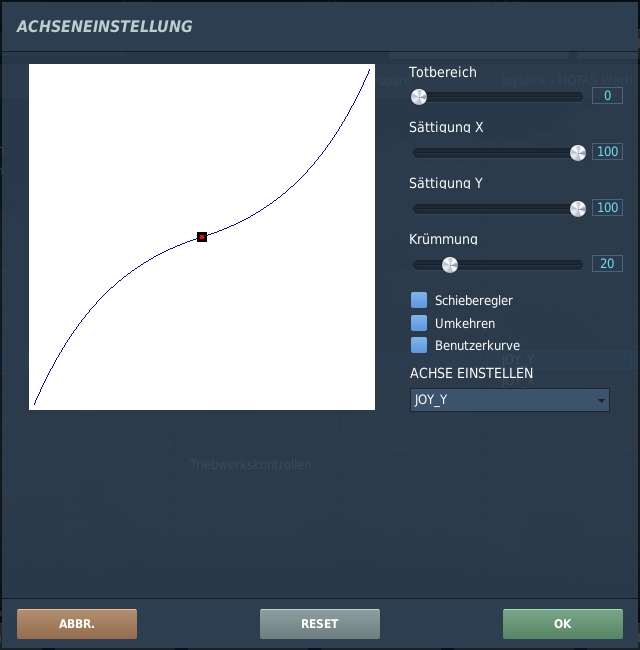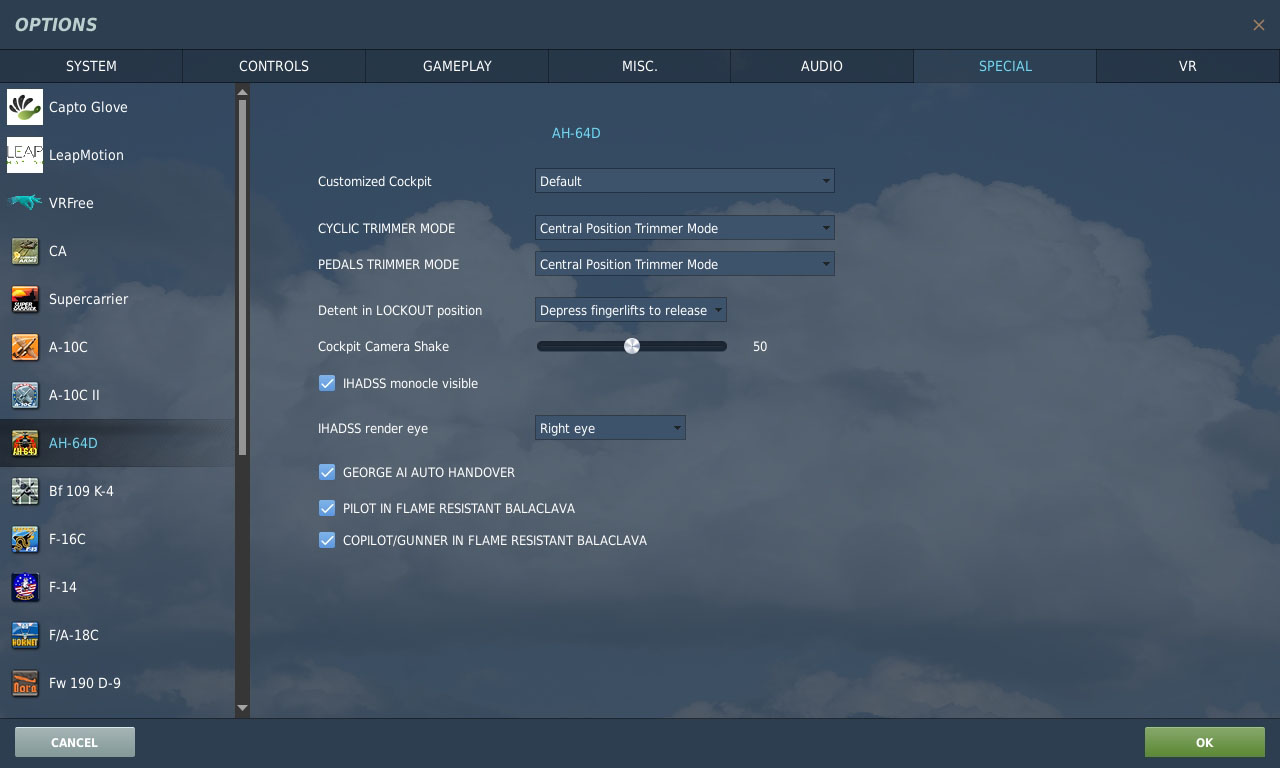Einstellungen
| Website: | Open Flight School |
| Kurs: | AH-64D Apache Basiskurs (DCS) |
| Buch: | Einstellungen |
| Gedruckt von: | Gast |
| Datum: | Montag, 15. Dezember 2025, 19:44 |
1. Einstellungen öffnen
Bevor wir loslegen, sollten wir uns kurz die Optionen von DCS zusammen anschauen.
Einzelheiten zu den Optionen solltest du zuerst im Kurs Allgemeine Grundlagen (DCS) unter Einstellungen von DCS nachlesen.
Auf den folgenden Seiten werden die Einstellungen beschrieben, die für den AH-64D-Basiskurs benötigt werden. Das sind vor allem die Steuerung und Spezialeinstellungen. Es wird davon ausgegangen, dass du weißt, wie man die Belegungen ändert. Falls das nicht der Fall ist, lies bitte im Kurs Allgemeine Grundlagen (DCS) das Kapitel Steuerung, bevor du hier weitermachst.
2. Achseneinstellung
Zunächst solltest du die Rubrik Achsenbefehle auswählen oder den Button ACHSE (unten, in der Mitte) drücken. Beides wechselt in die Liste der Aktionen, die du auf eine analoge Achse (Joystick oder Schubhebel) legen kannst. Jedes Gerät wird als eigne Spalte angezeigt, während die Aktionen als Zeile zu sehen sind (siehe Markierung unten). Die aufgelisteten Eingabegeräte heißen bei dir natürlich anders.
Von Haus aus sind da mit Sicherheit irgendwelche komischen Belegungen drin. Um alle zu löschen, wählst du der Reihe nach je ein Feld in einer Spalte aus (z. B. auf dem Screenshot VPC Stick...) und löschst dann die ganze Spalte mittels Kategorie löschen. Viele Anfänger haben z. B. Probleme durch doppelt belegte Achsen.
Klickst du danach doppelt auf eine Zelle (Schnittpunkt zwischen Zeile und Spalte), kannst du eine Achse belegen.
Die folgenden Achsen solltest du belegen:
| Aktion | Beschreibung | Bemerkung |
| Cyclic Roll (Querruder) | Rollachse - Querruderachse | Empfehlung: Krümmung 25 |
| Cyclic Pitch (Höhenruder) | Nickachse - Höhenruder | Empfehlung: Krümmung 25 |
| Rudder (Seitenruder) | Gieren - Seitenruder | Empfehlung: Krümmung 30 |
| Collective | Auftrieb | Steuert den Einstellwinkel und damit den Anstellwinkel der Rotorblätter, keine Krümmung einstellen |
Um die Empfindlichkeit der belegten Joystickachsen einzustellen, öffnest du über den Button ACHSENEINST. den Dialog ACHSENEINSTELLUNG:
3. Tastenbelegung
Im Basiskurs werden von der Startprozedur bis hin zur Landung nur wenige Tasten benötigt.
In der Regel sollte man die Standard-Tastaturbelegung beibehalten und diese um unbelegte Funktionen nach eigenen Wünschen erweitern.
Du kannst die Einstellungen natürlich nach deinen Bedürfnissen ändern, musst sie dann aber während der Mission kennen.
Eine Tastenkombination wird in diesem Kurs wie folgt dargestellt:
- Eine Standard-Tastenkombination wird so dargestellt: RShift + K
- Manchmal ist es nötig, zusätzliche Tastenkombinationen einzurichten. Diese werden dann so dargestellt: L
Folgende Tastaturbelegung ist nötig:
| Aktion | Beschreibung | Standardbelegung |
| Wheel Brake - ON/OFF | Vollbremsung beider Räder | W |
| Communication menu | Öffnet das Funkmenü | # |
| Kneeboard ON/OFF | Öffnet und schließt das Kniebrett | RShift + K |
| Kneeboard Glance | Öffnet das Kniebrett vorübergehend | K |
| Kneeboard Next Page | Blättert im Kniebrett eine Seite weiter | +*~ |
| Kneeboard Previous Page | Blättert im Kniebrett eine Seite zurück | Ü |
| Tail Wheel Lock/Unlock Button - Depress | Schaltet das Heckrad um (frei/arretiert) | L |
| Power Lever (Left) - IDLE | Schaltet die linke Motorleistung in IDLE-Position | RAlt + Home |
| Power Lever (Right) - IDLE | Schaltet die rechte Motorleistung in IDLE-Position | RShift + Home |
| Power Lever (Left) - OFF | Schaltet die linke Motorleistung in OFF-Position | RAlt + End |
| Power Lever (Right) - OFF | Schaltet die rechte Motorleistung in OFF-Position | RShift + End |
| Power Lever Step (Both) - Increase | Erhöht schrittweise die Moterleistung für beide Seiten | PageUp |
| Power Lever Step (Both) - Decrease | Verringert schrittweise die Moterleistung für beide Seiten | PageDown |
| Force Trim/Hold Mode Switch - R/Up | Trimmt die Steuerung | T |
Es gibt noch viele weitere Tastaturkommandos, aber man kann alle Schalter im Cockpit auch mit der Maus bedienen. Von daher sollte das für diesen Kurs erst mal reichen.
4. Spezialeinstellungen
Die speziellen Einstellungen erreichst du über die Optionen und dort den Reiter SPEZIAL.
Dort wählst du auf der linken Seite AH-64D aus. Hier kannst du verschiedene Einstellungen auswählen.
Customized Cockpit
Hier kannst du später das Aussehen des Cockpits auswählen. Zur Zeit gibt es nur ein Aussehen für das Cockpit (Default).
CYCLIC TRIMMER MODE
Hier kannst du das Verhalten der Trimmung für den Steuerknüppel einstellen:
- INSTANT TRIM (FFB FRIENDLY): Nur für Force-Feedback Joystick geeinget!
- Central Position Trimmer Mode: Für 95% aller Joysticks sinnvoll. Bitte verwenden!
- Joystick Without Springs and FFB: Nur für wenige selbstgebaute oder modifizierte Joysticks sinnvoll
Standardmäßig steht diese Einstellung auf INSTANT TRIM, was aber für die meisten Spieler mit ihren normalen Joystick falsch ist. Bitte stellt das auf Central Position Trimmer Mode um, außer Ihr wisst genau ihr braucht was anderes.
Später im Kurs wird es eine Anleitung geben, wie man die Trimmung einsetzt.
PEDALS TRIMMER MODE
Hier gibt es die gleichen Einstellungen wie bei CYCLIC TRIMMER MODE. Auch hier gilt, dass für die meisten Pedale der Central Position Trimmer Mode am besten geeignet ist.
Detent in LOCKOUT position
Im realen Hubschrauber muss man einen physikalischen Wiederstand überwinden, um den Leistungshebel von der FLY in die LOCKOUT Position zu bringen.
Mit dieser Option kann das Verhalten bei DCS eingestellt werden:
- Depress Fingerlifts to Release Locks: Hier muss du zuerst eine Taste drücken, damit du den Hebel in die LOCKOUT Position bringen kannst. Dies wird empfohlen wenn deine Achsen keinen physikalischen Wiederstand haben.
- Automatically Jump Over: Mit dieser Option werden die Leistungshebel der Triebwerksquadranten über die FLY-Position hinaus in die LOCKOUT-Position bewegt, ohne dass eine Arretierung vorhanden ist. Dies wird empfohlen wenn deine Gashebel mit physischen Rasten ausgestattet sind.
Cockpit Camera Shake
Hier kannst du einstellen wie stark das Cockpit vibriert.
IHADSS
Mit den Einstellungen zum IHADSS kannst du konfigurieren ob die Außenkanten des Monokels sichtbar sein sollen (monocle visible). Manche finden es toll die Umrisse zu sehen, andere stört es. Probiere beide Möglichkeiten aus und verwende was dir besser gefällt.
Du kannst auch einstellen vor welchem Auge das Monokel sitz (render eye). Das kommt erst in VR so richtig zum tragen. Am Monitor ist es wenig sinnvoll.
Stell es passent zu deinem dominanten Auge ein. Einfach beide Möglichkeiten testen und du wirst sehen was besser für dich funktioniert.
Die echten Piloten können sich das nicht aussuchen. Dort ist es immer rechts.
George AI AUTO HANDOVER
Ist diese Option aktiviert und du wechselst vom Piloten-Sitz zum Platz des CPG, dann übernimmt George (der KI-Pilot) automatisch die Kontrolle. Ist sie deaktiviert, dann behält der Spieler die Kontrolle und muss George mittels Befehl die Kontrolle übergeben.
Balaclava
Hier kannst du einstellen ob der Pilot und/oder der CPG eine Balaclava (Sturmhaube) tragen sollen.




